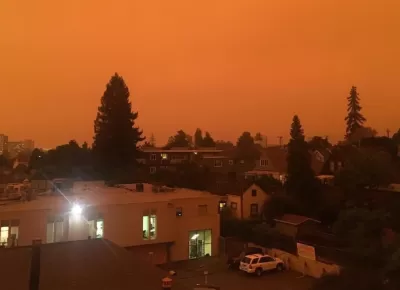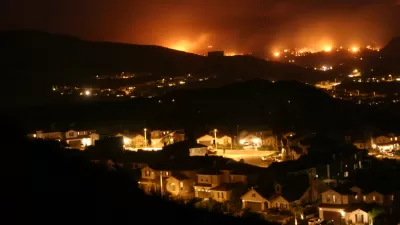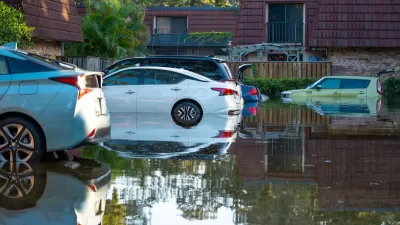Home insurers argue they should be able to base policy costs on modeling that accounts for future risks from climate change and overdevelopment.

The home insurance industry is calling on California to discourage construction in fire-prone zones by allowing insurers to account for future risks when evaluating policy applications. With climate change causing more extreme wildfire seasons and development pushing farther into high-risk areas, reports Debra Kahn, California insurers anticipate increasingly severe damage from wildfires. Meanwhile, homeowners in fire zones are finding it more difficult to secure policies or seeing their rates rise dramatically, even through the state's last-resort option, the FAIR plan. In October, the state temporarily banned insurers from dropping homeowners in areas affected by recent major wildfires.
Consumer watchdog groups warn that the proposed model, dubbed "catastrophic modeling" and used in every state except California, would defy consumer protection laws, and the state's insurance commissioner, Ricardo Lara, has shown reluctance to change the policy, opting to focus on a "consumer-oriented" approach that protects homeowners from exorbitant rate hikes. State politicians are similarly hesitant to dictate where development can happen, citing concerns that restrictions on construction could worsen the state's housing shortage.
But some experts warn that increased reliance on the FAIR program for the highest-risk homeowners could put an undue burden on taxpayers, much like FEMA's beleaguered flood insurance program. In Florida, which experiences frequent hurricanes and flooding, regulations on the insurance industry tie insurance to "more-stringent building codes, with incentives for going beyond the standards to install the sturdiest doors and windows" to reduce risks.
FULL STORY: California continues to face wildfire risks. Insurers think they have an answer.

Planetizen Federal Action Tracker
A weekly monitor of how Trump’s orders and actions are impacting planners and planning in America.

Restaurant Patios Were a Pandemic Win — Why Were They so Hard to Keep?
Social distancing requirements and changes in travel patterns prompted cities to pilot new uses for street and sidewalk space. Then it got complicated.

Map: Where Senate Republicans Want to Sell Your Public Lands
For public land advocates, the Senate Republicans’ proposal to sell millions of acres of public land in the West is “the biggest fight of their careers.”

Maui's Vacation Rental Debate Turns Ugly
Verbal attacks, misinformation campaigns and fistfights plague a high-stakes debate to convert thousands of vacation rentals into long-term housing.

San Francisco Suspends Traffic Calming Amidst Record Deaths
Citing “a challenging fiscal landscape,” the city will cease the program on the heels of 42 traffic deaths, including 24 pedestrians.

California Homeless Arrests, Citations Spike After Ruling
An investigation reveals that anti-homeless actions increased up to 500% after Grants Pass v. Johnson — even in cities claiming no policy change.
Urban Design for Planners 1: Software Tools
This six-course series explores essential urban design concepts using open source software and equips planners with the tools they need to participate fully in the urban design process.
Planning for Universal Design
Learn the tools for implementing Universal Design in planning regulations.
Heyer Gruel & Associates PA
JM Goldson LLC
Custer County Colorado
City of Camden Redevelopment Agency
City of Astoria
Transportation Research & Education Center (TREC) at Portland State University
Camden Redevelopment Agency
City of Claremont
Municipality of Princeton (NJ)





























